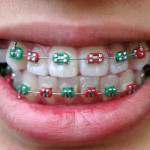
Orthodontic treatment is achieved through the application of light forces to the teeth to achieve the required tooth movements. This is commonly associated with pain which has been reported in the majority of patients. Pain during treatment is also a common reason for patients discontinuing treatment.
The aim of this Cochrane review was to determine the effectiveness of drug interventions for pain relief during orthodontic treatment and whether there is a difference in the analgesic effect provided by different types, forms and doses of analgesia taken during orthodontic treatment.
Methods
Searches were conducted in the Cochrane Oral Health Trials Register, Cochrane Central Register of Controlled Trials (CENTRAL), Medline, Embase, CINAHL (Cumulative Index to Nursing and Allied Health) The US National Institutes of Health Ongoing Trials Register (ClinicalTrials.gov) and the World Health Organization International Clinical Trials Registry Platform with no restrictions on language or date.
Randomised controlled trials of pain control during orthodontic treatment were considered. Pain being measured using visual analogue scale (VAS), numerical rating scale (NRS) or categorical scale. Two reviewers independently selected studies, abstracted data and assessed risk of bias using standard Cochrane methodology. Meta-analysis was carried out where there were studies of similar comparisons reporting the same outcomes.
Results
- 32 RCTs involving a total of 3110 patients were included.
- 21 studies were considered to be a high risk of bias, 10 at unclear risk, just 1 at low risk.
- 12 studies contributed to meta-analyses.
- There was
- moderate-quality evidence that analgesics effectively reduced pain following orthodontic treatment when compared to no treatment or a placebo at 2 ,6 and 24hours.
| No of studies
(patients) |
Mean difference
VAS scale |
95% Confidence
interval |
|
| 2hrs | 10 (685) | -11.66 mm | -16.15 to -7.17 |
| 6hrs | 9 (535) | -24.27 mm | -31.44 to -17.11 |
| 24hrs | 12 (1012) | -21.19 mm | -28.31 to -14.06 |
- No evidence of a difference in efficacy between NSAID and paracetamol at 2, 6 or 24 hours.
- Very low-quality evidence suggested pre-emptive ibuprofen gave better pain relief at 2 hours than ibuprofen taken post treatment (MD -11.30, 95% CI -16.27 to -6.33; one study, 41 participants), however, the difference was no longer significant at 6 or 24 hours.
- A single study of 48 participants compared topical NSAIDs versus local anaesthetic and showed no evidence of a difference in the effectiveness of the interventions (very low-quality evidence).
- Use of rescue analgesia was poorly reported.
- In one study one patient developed a rash provisionally diagnosed as a hypersensitivity to paracetamol that required treatment with antihistamines.
Conclusions
The authors concluded: –
Analgesics are more effective at reducing pain following orthodontic treatment than placebo or no treatment. Low-quality evidence did not show a difference in effectiveness between systemic NSAIDs compared with paracetamol, or topical NSAIDs compared with local anaesthetic. More high-quality research is needed to investigate these comparisons, and to evaluate pre-emptive versus post-treatment administration of analgesics.
Comments
This Cochrane review found moderate quality evidence that the use of analgesics reduce pain associated with orthodontic treatment. However, evidence is lacking to say which type of analgesic is most effective. A previous Cochrane review looked at pre-treatment analgesia for children undergoing dental treatment (Dental Elf – 15th Aug 2016) and their finding support this review short term (2hr) findings in relation to ibuprofen.
This review updates earlier non-Cochrane reviews (Dental Elf – 11th May 2012)looking at this topic. It is also worth noting the companion Cochrane review that looked at non-pharmacological interventions for orthodontic pain (Dental Elf – 11th Jan 2017) which in the main was inconclusive although there was some suggestion that low level laser may have some short –term benefit.
Links
Primary Paper
Monk AB, Harrison JE, Worthington HV, Teague A. Pharmacological interventions for pain relief during orthodontic treatment. Cochrane Database of Systematic Reviews 2017, Issue 11. Art. No.: CD003976. DOI: 10.1002/14651858.CD003976.pub2.
Other references
Cochrane Oral Health Group Blog –
How effective are painkillers in reducing the discomfort caused by orthodontic treatment?
Dental Elf – 11th Jan 2017
Pain during orthodontic treatment: non-pharmacological interventions
Dental Elf – 15th Aug 2016
Do analgesics before dental treatment reduce post treatment pain in children?
Dental Elf – 11th May 2012
Analgesics for pain experienced by patients having orthodontic treatment

[…] Pain during orthodontic treatment –pharmacological treatments […]